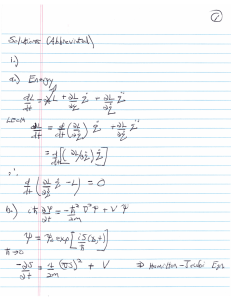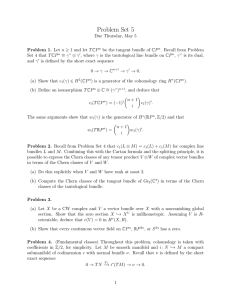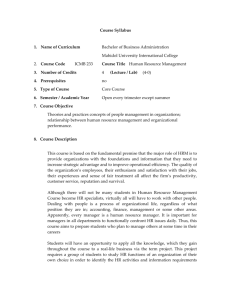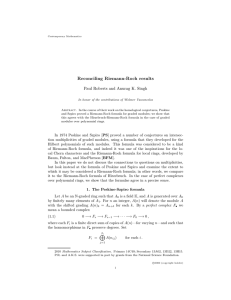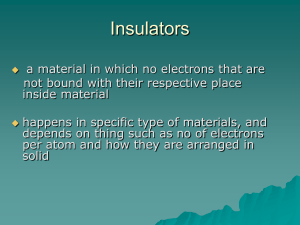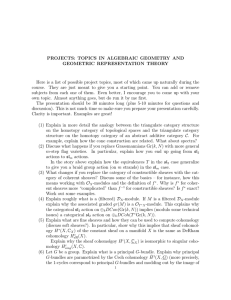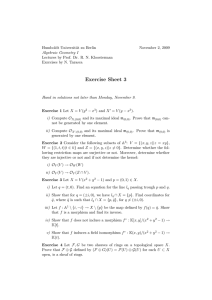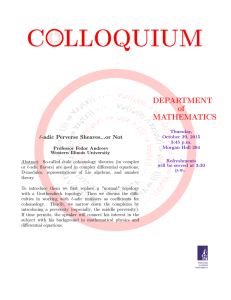Introduction to the Strange Duality Conjecture for Surfaces February 1, 2016
advertisement
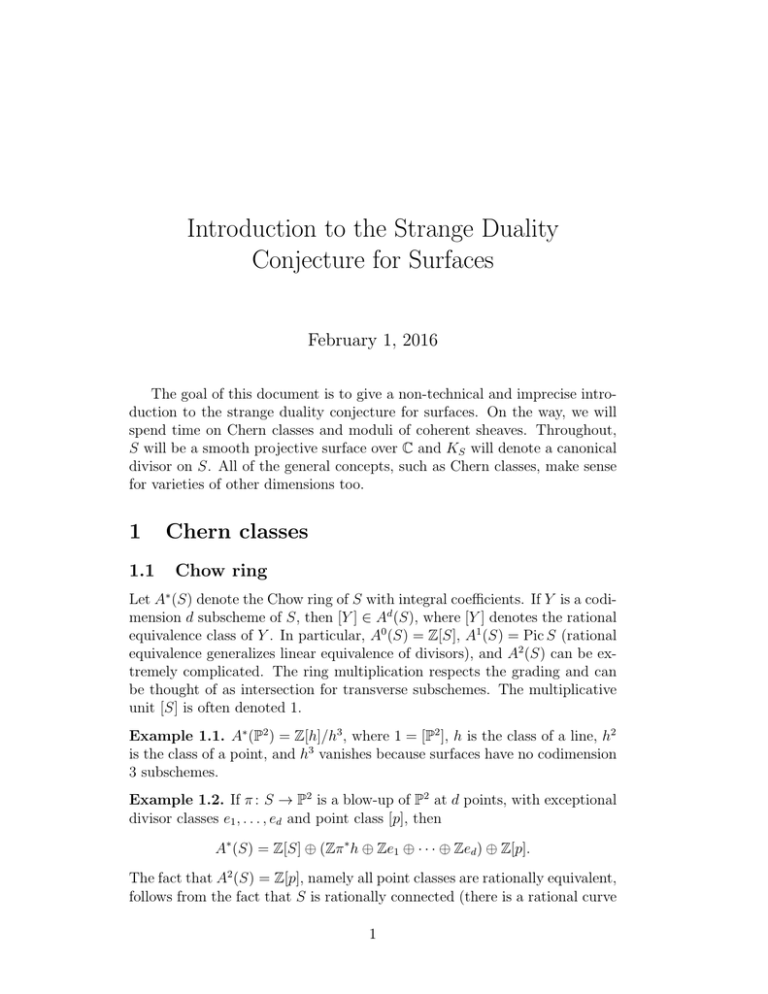
Introduction to the Strange Duality
Conjecture for Surfaces
February 1, 2016
The goal of this document is to give a non-technical and imprecise introduction to the strange duality conjecture for surfaces. On the way, we will
spend time on Chern classes and moduli of coherent sheaves. Throughout,
S will be a smooth projective surface over C and KS will denote a canonical
divisor on S. All of the general concepts, such as Chern classes, make sense
for varieties of other dimensions too.
1
1.1
Chern classes
Chow ring
Let A∗ (S) denote the Chow ring of S with integral coefficients. If Y is a codimension d subscheme of S, then [Y ] ∈ Ad (S), where [Y ] denotes the rational
equivalence class of Y . In particular, A0 (S) = Z[S], A1 (S) = Pic S (rational
equivalence generalizes linear equivalence of divisors), and A2 (S) can be extremely complicated. The ring multiplication respects the grading and can
be thought of as intersection for transverse subschemes. The multiplicative
unit [S] is often denoted 1.
Example 1.1. A∗ (P2 ) = Z[h]/h3 , where 1 = [P2 ], h is the class of a line, h2
is the class of a point, and h3 vanishes because surfaces have no codimension
3 subschemes.
Example 1.2. If π : S → P2 is a blow-up of P2 at d points, with exceptional
divisor classes e1 , . . . , ed and point class [p], then
A∗ (S) = Z[S] ⊕ (Zπ ∗ h ⊕ Ze1 ⊕ · · · ⊕ Zed ) ⊕ Z[p].
The fact that A2 (S) = Z[p], namely all point classes are rationally equivalent,
follows from the fact that S is rationally connected (there is a rational curve
1
through any two points). Since all point classes are equivalent, we can think
of multiplication A1 (S) × A1 (S) → A2 (S) ' Z as being the intersection
product.
For more general surfaces with larger A2 (S), we can think of the intersection product as the composition
/ A2 (S) deg /
A1 (S) × A1 (S)
Z
of the Chow multiplication and the degree map that counts points.
Think of A∗ (S) as an algebraic version of the cohomology ring H ∗ (S).
The two can be equal for nice varieties (such as P2 ) but can also differ in
complicated ways. There is a ring morphism A∗ (S) → H ∗ (S) which need be
neither injective nor surjective. As we will see later, it is sometimes more
convenient to work in cohomology when rational equivalence is too strong
(for instance when A2 (S) is extremely complicated).
1.2
Definition of Chern classes
Let E be a locally free coherent sheaf (a vector bundle) on S of rank r.
Suppose E is globally generated, namely H 0 (E) ⊗ OS → E is surjective.
Then the Porteous formula says that for a general choice of n global sections
of E, the image of On → E drops to rank ≤ k on a codimension (n − k)(r −
k) subscheme whose class in A(n−k)(r−k) (S) is det(cr−k+j−i (E))1≤i,j≤n−k (the
matrix is (n−k)×(n−k) and has cr−k on the diagonal). In particular, r−i+1
general sections of E drop to rank ≤ r − i on a locus of class ci (E) ∈ Ai (E).
We can think of this as being a geometric definition of Chern classes.
Definition 1.3. The ith Chern class ci (E) of a globally generated vector
bundle E of rank r is the class in Ai (E) of the locus where r − i + 1 general
sections of E drop to rank ≤ r − i.
Here are some simple observations:
• Since dim S = 2, the Chow ring has no classes of codimension > 2.
Thus ci (E) = 0 for all i ≥ 3.
• If E has rank r, then by definition ci (E) = 0 for all i > r because ranks
cannot be negative.
• c0 (E) = [S] ∈ A0 (S), which we usually write as c0 (E) = 1.
2
Example 1.4. Let OS (D) be an invertible sheaf with D ≥ 0 and |D| basepoint free. Then OS (D) is globally generated. The sections H 0 (OS (D)) can
be thought of as rational functions f ∈ C(S) that are allowed to have a
pole only along D, namely div(f ) = D0 − D for some effective D0 ∼ D.
This section vanishes exactly on D0 , so c1 (OS (D)) = [D0 ]. This class is
independent of the choice of section since rational equivalence coincides with
linear equivalence for divisors, so we may make the more natural choice
c1 (OS (D)) = [D].
Example 1.5. The Euler sequence on S = P2 yields
0 → OP2 (−1) → OP⊕3
2 → TP2 (−1) → 0
which shows that TP2 (−1) is a rank 2 vector bundle generated by its three
global sections. Since these three sections do not drop to rank ≤ 1 anywhere,
c1 (TP2 (−1))2 − c2 (TP2 (−1)) = 0. We will compute these classes shortly.
1.3
Functoriality
Putting all the Chern classes into the Chern polynomial c(E) = 1 + c1 (E)t +
c2 (E)t2 , where the power of t records the codimension, is convenient because
Chern polynomials are multiplicative on short exact sequences: if 0 → E 0 →
E → E 00 → 0 is a short exact sequence of vector bundles, then c(E) =
c(E 0 )c(E 00 ).
L
Example 1.6. Since c(OS (D)) = 1+Dt, the Chern polynomial of ki=1 OS (Di )
is
!
!
k
k
Y
X
X
(1 + Di t) = 1 +
Di t +
Di Dj t2 ,
i=1
i=1
1≤i<j≤k
where each Di Dj is a product in the Chow ring. In particular, c(OS⊕k ) = 1.
Example 1.7. Taking Chern polynomials in the short exact sequence of
Example 1.5, we get
c(OP2 )3 = c(OP2 (−1))c(TP2 (−1)),
from which compute c(TP2 (−1)) = 1 + ht + h2 t2 , which satisfies our above
equation.
Chern classes have many other nice properties, such as functoriality under
pullbacks. If f : S 0 → S is a morphism of surfaces and E is a vector bundle
on S, then c(f ∗ E) = f ∗ c(E), where the latter f ∗ is pullback on Chow rings.
3
1.4
Chern characters
Chern characters are a modification of Chern classes that have some nicer
functorial properties. The Chern characters chi (E) ∈ Ai (S) of a vector
bundle E of rank r can be defined as follows:
ch0 (E) = r;
ch1 (E) = c1 (E);
ch2 (E) = 12 c1 (E)2 − c2 (E).
Note that ch0 is more meaningful than c0 , but ch2 lacks a nice geometric
interpretation. Moreover, in order to accommodate ch2 , we have to allow
rational coefficients in the Chow ring.
Define the Chern character of E to be ch(E) = ch0 (E)+ch1 (E)+ch2 (E) ∈
A∗ (S). A huge advantage of working with Chern characters is that they are
additive on short exact sequences: if 0 → E 0 → E → E 00 → 0 is a short
exact sequence of vector bundles, then ch(E) = ch(E 0 ) + ch(E 00 ). Moreover,
ch is multiplicative on tensor products of vector bundles: ch(E ⊗ E 0 ) =
ch(E)ch(E 0 ). (These nice properties can be summarized by saying that
ch : K(S) → A∗ (S) is a ring morphism, where K(S) is the Grothendieck
group of S.)
Example 1.8. Computing Chern characters for our previous examples, we
get ch(OS (D)) = 1+D+ 21 D2 and ch(TP2 (−1)) = 3−(1−h+ 12 h2 ) = 2+h− 12 h2 .
Using locally free resolutions, additivity allows us to define Chern characters for coherent sheaves that are not locally free.
Example 1.9. Given p ∈ P2 , choosing two lines that intersect at p yields a
resolution
0 → OP2 (−2) → OP2 (−1) ⊕ OP2 (−1) → Ip → 0,
which allows us to compute ch(Ip ) = 2(1 − h + 21 h2 ) − (1 − 2h + 2h2 ) = 1 − h2 .
Moreover, the short exact sequence 0 → Ip → OP2 → Cp → 0 allows us to
compute ch(Cp ) = h2 . More generally, if Z is a 0-dimensional subscheme of
length n, then ch(IZ ) = 1 − nh2 and ch(ι∗ OZ ) = nh2 , where ι : Z ,→ P2 .
1.5
Euler characteristic
The Euler characteristic of a coherent sheaf E is defined to be χ(E) = h0 (E)−
h1 (E) + h2 (E). The Hirzebruch-Riemann-Roch theorem yields
χ(E) = deg[ch(E) td(S)]2 = # of points in [ch(E) td(S)]2 ,
where [·]2 denotes the codimension 2 part in A∗ (S), and td(S) is the Todd
class of S, defined to be
td(S) = 1 − 21 KS +
4
1
(KS2
12
+ c2 (TS )).
1
Example 1.10. Taking E = OS , we see that deg 12
(KS2 + c2 (TS ) = χ(OS ),
which together with deg c2 (TS ) = χtop (S) yields Nöther’s formula .
Example 1.11. More generally, let E = OS (D) be any line bundle. Then
1
χ(OS (D)) = deg (1 + D + 21 D2 )(1 − 12 KS + 12
(KS2 + c2 (TS )) 2
= 21 D.D − 12 D.KS + χ(OS )
recovers the standard Riemann-Roch formula for surfaces.
Hirzebruch-Riemann-Roch implies that for a fixed surface S, χ(E) depends only on the Chern character of E. Indeed, for ch(E) = (r, c1 , ch2 ), we
compute
χ(E) = rχ(OS ) − 21 c1 .KS + deg ch2 .
Thus χ(E) is quite easy to compute. One reason why χ(E) is useful is that
it gives us information about the more mysterious cohomology groups. We
often have vanishing of h2 (E), which by Serre duality is equal to h0 (E ∗ ⊗ωS ),
in which case the inequality h0 (E) ≥ χ(E) guarantees the existence of global
sections when χ(E) is positive.
Example 1.12. Let p1 , p2 , p3 ∈ P2 be distinct points. Then OP2 (1) ⊗ I∪pi is
a coherent sheaf with
χ(OP2 (1) ⊗ I∪pi ) = χ(OP2 ) − 21 h.(−3h) + 21 h.h − 3 = 0.
Another way to see this is to use the short exact sequence
0 → OP2 (1) ⊗ I∪pi → OP2 (1) → O∪pi → 0
and its associated cohomology long exact sequence, which yields H 2 (OP2 (1)⊗
I∪pi ) = 0 and
0 → H 0 (OP2 (1) ⊗ I∪pi ) → C3 → C3 → H 1 (OP2 (1) ⊗ I∪pi ) → 0
The middle map fails to be an isomorphism exactly when there is a line in P2
that vanishes at ∪pi , namely when the pi are colinear. Thus the cohomology
groups H 0 and H 1 of OP2 (1) ⊗ I∪pi depend on the geometry of the pi : they
vanish when the pi are general and jump to dimension 1 when the pi are
colinear. We can also see this by thinking of the global sections of OP2 (1) ⊗
I∪pi as those sections of OP2 (1) that vanish on ∪pi and observing that there
is a linear equation vanishing on ∪pi ⇐⇒ the pi are colinear.
5
The previous example is typical. If we fix the Chern character of a sheaf
E that yields χ(E) = 0, we expect that general E with that Chern character
will have vanishing cohomology groups, but the dimensions of these groups
may jump for special E. Thus we can get information about general sheaves
in M (ch(E)), the moduli space of coherent sheaves with Chern character
ch(E).
Note also that the formula for χ does not use the fine structure of, say,
2
A (S). It is more natural to view χ is a function on H ∗ (S) and we will
think of our Chern characters as element of H ∗ (S) when discussing moduli
of sheaves in the next section.
2
Moduli of sheaves
Fix a Chern character e ∈ H ∗ (S). Then M (e) denotes the set of all isomorphism classes of semi-stable coherent sheaves on S with Chern character e
up to isomorphism. Semistability is a technical condition depending on a
choice of ample divisor on S that rules out most direct sums and makes it
possible to give the moduli the structure of a finite-dimensional scheme. The
basic idea of the construction of M (e) is to uniformly twist these sheaves to
make them globally generated and thus to realize them as the points of a
Quot scheme. Then taking a GIT quotient on the semi-stable elements of
the Quot scheme gives the moduli space. It is necessary to use H ∗ (S) instead of A∗ (S) because the construction picks out all sheaves with the same
Hilbert polynomial, which is defined using the Euler characteristic and hence
depends only on the cohomology classes and not the finer structure of A∗ (S).
Example 2.1. On P1 , the moduli of all sheaves with Chern character 2 +
0[p] contains the infinitely many discrete points OP1 (a) ⊕ OP1 (−a) for a ∈
Z≥0 , which cannot coexist in a bounded (finite-dimensional) family since the
Mumford-Castelnuovo regularity of these sheaves is unbounded. The only
semistable sheaf of this type is OP1 ⊕ OP1 .
Another nice application the Chern character is an expected dimension
formula for the moduli M (e) of semi-stable sheaves. Writing e = e0 + e1 + e2
with ei ∈ Ai (S), the formula is
expdim M (e) = deg(e21 − 2e0 e2 − e20 + 1).
On P2 , this expected dimension always equals the actual dimension when the
discriminant ∆, which can be computed from e, lies above a particular curve
called the delta curve.
6
Example 2.2. Let e = 1 + D + 12 D2 . Then M (e) = {OS (D)} is a single
point. We call e a rigid Chern character when the associated moduli space is
a single point. Note that the expected dimension D2 − D2 − 1 + 1 = 0 agrees
with the actual dimension.
One of the best understood classes of moduli spaces are the Hilbert
schemes of points Hilbn (S), which parametrize all ideal sheaves of n points on
S (equivalently, all length n subschemes of S). Since H 2 (S) = Z[p] (note that
A2 (S) may be more complicated!), we have Hilbn (S) = M (1 − n[p]). Since
each of the n points is chosen on the 2-dimensional surface, dim Hilbn (S) =
2n, which agrees with the expected dimension computation 0 + 2n − 1 + 1.
Note that these ideal sheaves can correspond to non-reduced subschemes
at points, which can be thought of as recording tangency information. For
instance, a length 2 non-reduced subscheme is an inclusion C[x]/x2 ,→ S,
namely a tangent direction at a point of S.
Example 2.3. Hilbert schemes of points can be nicely described for small
n: Hilb0 (S) = {OS }; Hilb1 (S) ' S; Hilb2 (S) = Bl∆ Sym2 S.
3
Strange duality
Fix a pair of Chern characters e, f ∈ A∗ (S) that are orthogonal, namely
deg[ef td S]2 = 0. Another way of expressing this orthogonality is that for
general E ∈ M (e) and F ∈ M (f ), all cohomology groups of E ⊗ F vanish
since χ(E ⊗ F ) = 0. Consider the diagram
M (e) × M (f )
p
q
'
x
M (e)
M (f )
and define the cohomology jumping locus Θ ⊂ M (e)×M (f ) as Θ = {(E, F ) : h0 (E⊗
F ) > 0}, which in nice cases is a divisor, called a theta divisor. For general
fixed F0 ∈ M (f ) and E0 ∈ M (e), define
ΘF0 := Θ|M (e)×{F0 } = {E ∈ M (e) : h0 (E ⊗ F0 ) > 0} ⊂ M (e)
and
ΘE0 := Θ|{E0 }×M (e) {F ∈ M (f ) : h0 (V0 ⊗ F ) > 0} ⊂ M (f ),
which are also called theta divisors, and whose linear equivalence class is independent of chosen general F0 and E0 . Then O(Θ) = q ∗ O(ΘF0 ) ⊗ p∗ O(ΘE0 )
7
(we often abbreviate the tensor products of pullbacks using the box product
notation O(ΘF0 ) O(ΘE0 )) by a seesaw argument, so the Künneth formula
yields H 0 (O(Θ)) ' H 0 (O(ΘF0 )) ⊗ H 0 (O(ΘE0 )) and Θ itself picks out a particular line in this vector space. In other words, we have
CΘ ⊂ H 0 (O(ΘF0 )) ⊗ H 0 (O(ΘE0 ))
which induces a morphism
SDΘ : H 0 (O(ΘF0 ))∗ → H 0 (O(ΘE0 )).
The strange duality conjecture says that this morphism is always an isomorphism unless it is zero for some special reason.
In general, ifPV and W are vector spaces and the image of C ,→ V ⊗ W
is
vi ⊗ wi , then the induced morphism V ∗ → W is φ 7→
P spanned by
φ(vi )wi . For this to be an isomorphism, it is of course necessary to have
dim V = dim W , so let us assume this and call the dimension n. If
Pwe now let
{vi } and {wi } denote bases of V and W , our line is spanned by
aij vi ⊗ wj
and the induced map V ∗ → W is given in these coordinates by the matrix
(aij )T . Thus the induced map is an isomorphism exactly when (aij ) is an
invertible matrix.
Example3.1. Let S = P2 . Choose positive integers n, m, d such that n +
m = d+2
. Let e = 1 − nh2 and f = 1 + dh + ( 21 d2 − m)h2 , which are
2
orthogonal. Then M (e) = Hilbn (P2 ) and M (f ) ∼
= Hilbm (P2 ), where the latter
parametrizes ideal sheaves of m points twisted by OP2 (d). The orthogonality
comes from the fact that for general IZ ∈ Hilbn (P2 ) and IY ∈ Hilbm (P2 ),
IZ ⊗ IY ⊗ OP2 (d)
no curve of degree d vanishes
has no global sections since
1
on n + m = d+2
general
points,
and
no
H
since
the n + m linear vanishing
2
0
conditions are independent on H (OP2 (d)). We will explicitly show that SDΘ
is an isomorphism in this case.
Consider the diagram
Hilbn (P2 )
/
Gr(m, H 0 (OP2 (d)))
ι
/
V
P ( m H 0 (OP2 (d))) = PM .
The first map sends IZ to the polynomials vanishing on Z, which is only
defined when the n points impose independent conditions on H 0 (OP2 (d)),
but the locus of indeterminacy has codimension ≥ 2, so there is no trouble
pulling back divisors. The morphism ι is the Plücker embedding, which can
be made explicit by choosing a basis {e1 , . . . , em+n } of H 0 (OP2 (d)) . Given
an m-dimensional subspace V ⊂ H 0 (OP2 (d) in the Grassmannian, we can
choose a basis {b1 , . . . , bm } for V , and then ι(V ) = b1 ∧ · · · ∧ bm , which can be
8
V
expanded in terms of the basis {eI = ei1 ∧· · ·∧eim } of m H 0 (OP2 (d)), where
I = (i1 , . . . , im ) with 1 ≤ i1 < · · · < im ≤ d+2
. The coordinate functions
2
M
∗
on P are the dual basis {eI }. Of course we can consider the same setup for
Hilbm (P2 ) as well.
Using abbreviated notation, we want to identify Θ as a pullback of a
divisor on PM × PN via the maps
/
Hilbn × Hilbm
Gr(m) × Gr(n)
ι
/
PM × PN .
Let X ⊂ PM × PN denote the image of the composition above. We will
show that as a divisor on X, Θ is cut out by the bihomogeneous (1,1)-form
P
sgn(I) e∗I ⊗ e∗I c , where I c denotes the complement of I in (1, 2, . . . , m + n)
and sgn I is +1 (resp. −1) if the number of swaps required to put the sequence
(I, I c ) in ascending order is even (resp. odd).
We can think of Θ as pairs (Z, Y ), where Z is a collection
of n points
d+2
and Y is a collection of m points, with m + n = 2 , such that there is
a degree d polynomial vanishing on Z ∪ Y (namely h0 (IZ ⊗ IY ⊗ OP2 (d)) >
0). In Gr(m) × Gr(n), this corresponds to pairs of subspaces (V, W ), with
dim V = m and dim W = n, such that V ∩W 6= 0. Another way of describing
the condition V ∩ W 6= 0 is saying the wedge of a basis of V with a basis
of W should be zero. But the wedge of two bases of complementary size is
particularly easy to compute since the only nonzero terms come from wedges
of eI with
under ι, the image of Θ is cut out inside X by the zero
P eI c . Thus
set of
sgn(I) e∗I ⊗ e∗I c , as claimed.
Summarizing, O(Θ) is isomorphic to the V
pullback of OPM (1)O
Vn P0N (1) and ∗
m
0
0
∗
Θ,P
as an element of H (OPM (1)OPN (1)) '
H (OP2 (d)) ⊗ H (OP2 (d)) ,
is I e∗I ⊗ e∗I c , which induces the natural non-degenerate pairing
m
^
0
H (OP2 (d)) ⊗
n
^
0
H (OP2 (d)) →
m+n
^
H 0 (Θ(d)) ∼
= C.
Thus the strange duality map is indeed an isomorphism.
By the work of Alina Marian and Dragos Oprea, the strange duality
conjecture is known to hold for general K3 surfaces and a modified version
holds for abelian surfaces. Only a few examples are known for P2 and other
del Pezzo surfaces. There is also a formulation of strange duality on curves,
which was proven for all curves by Marian and Oprea as well as Prakash
Belkale.
9
